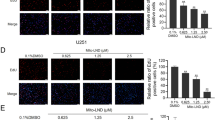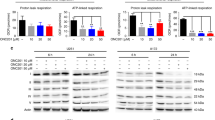Abstract
The mesoionic compound 4-phenyl-5-(4-nitro-cinnamoyl)-1,3,4-thiadiazolium-2-phenylamine chloride (MI-D) impairs mitochondrial oxidative phosphorylation and has a significant antitumour effect against hepatocarcinoma and melanoma. This study evaluated the cytotoxic effect of MI-D on T98G glioblastoma cells and investigated whether the impairment of oxidative phosphorylation promoted by MI-D is relevant to its cytotoxic effect. The effects of MI-D on T98G cells cultured in high glucose Dulbecco’s modified Eagle’s medium (DMEM) HG (glycolysis-dependent) and galactose plus glutamine-supplemented Dulbecco’s modified Eagle’s medium (DMEM) GAL (oxidative phosphorylation-dependent) were compared. T98G cells grown in DMEM GAL medium exhibited higher respiration rates and citrate synthase activity and lower lactate levels, confirming the metabolic shift to oxidative phosphorylation in these cells. MI-D significantly decreased the cell viability in a dose-dependent manner in both media; however, T98G cells cultured in DMEM GAL medium were more susceptible. The mesoionic significantly inhibited mitochondrial oxidative phosphorylation of glioma cells in both media. At the same time, lactate levels were not altered, indicating an absence of compensatory glycolysis activation. Additionally, MI-D increased the citrate synthase activity of cells in both media, which in DMEM HG-cultivated cells was followed by citrate accumulation. Apoptosis dependent on caspase-3 mediated the toxicity of MI-D on T98G cells. The higher susceptibility of glioma cells cultured in DMEM GAL medium to MI-D indicates that the impairment of mitochondrial functions is involved in mesoionic cytotoxicity. The results of this study indicate the potential use of MI-D for glioblastoma treatment.






Similar content being viewed by others
Data availability
All data collected and analysed during the current study are available from the corresponding author on reasonable request.
References
Agnihotri S, Zadeh G (2016) Metabolic reprogramming in glioblastoma: the influence of cancer metabolism on epigenetics and unanswered questions. Neuro Oncol 18:160–172. https://doi.org/10.1093/neuonc/nov125
Colquhoun A (2017) Cell biology-metabolic crosstalk in glioma. Int J Biochem Cell Biol 89:171–181
Hanif F, Muzaffar K, Perveen K et al (2017) Glioblastoma multiforme: a review of its epidemiology and pathogenesis through clinical presentation and treatment. Asian Pacific J Cancer Prev 18:3–9. https://doi.org/10.22034/APJCP.2017.18.1.3
Jhanwar-Uniyal M, Labagnara M, Friedman M et al (2015) Glioblastoma: Molecular pathways, stem cells and therapeutic targets. Cancers (Basel) 7:538–555. https://doi.org/10.3390/cancers7020538
Pucko E, Matyja E, Koronkiewicz M et al (2018) Potent antitumour effects of novel pentabromobenzylisothioureas studied on human glial-derived tumour cell lines. Anticancer Res 38:2691–2705. https://doi.org/10.21873/anticanres.12511
Le Rhun E, Preusser M, Roth P et al (2019) Molecular targeted therapy of glioblastoma. Cancer Treat Rev 80:101896. https://doi.org/10.1016/j.ctrv.2019.101896
Zanders ED, Svensson F, Bailey DS (2019) Therapy for glioblastoma: is it working? Drug Discov Today 24:1193–1201. https://doi.org/10.1016/j.drudis.2019.03.008
Senff-Ribeiro A, Echevarria A, Silva EF et al (2004) Cytotoxic effect of a new 1,3,4-thiadiazolium mesoionic compound (MI-D) on cell lines of human melanoma. Br J Cancer 91:297–304. https://doi.org/10.1038/sj.bjc.6601946
Senff-Ribeiro A, Echevarria A, Silva ER et al (2004) Antimelanoma activity of 1,3,4-thiadiazolium mesoionics: a structure-activity relationship study. Anticancer Drugs 15:269–275
Pereira RA, Pires ARA, Echevarria A et al (2021) The toxicity of 1,3,4-thiadiazolium mesoionic derivatives on hepatocarcinoma cells (HepG2) is associated with mitochondrial dysfunction. Chem Biol Interact 349:109675. https://doi.org/10.1016/j.cbi.2021.109675
Gozzi GJ, Andrade R, Valdameri G et al (2015) Selective cytotoxicity of 1,3,4-thiadiazolium mesoionic derivatives on hepatocarcinoma cells (HepG2). PLoS ONE. https://doi.org/10.1371/journal.pone.0130046
Kier LB, Roche EB (1967) Medicinal chemistry of the mesoionic compounds. J Pharm Sci 56:149–168. https://doi.org/10.1002/jps.2600560202
Shinzato TO, Grynberg N, Gomes R et al (1989) Antitumor activity of new mesoionic compounds against three murine tumors. J Med Sci Res 17:865–866
Parone PA, James D, Martinou JC (2002) Mitochondria: regulating the inevitable. Biochimie 84:105–111. https://doi.org/10.1016/s0300-9084(02)01380-9
Xie L, Shi F, Tan Z et al (2018) Mitochondrial network structure homeostasis and cell death. Cancer Sci 109:3686–3694. https://doi.org/10.1111/cas.13830
Cadena SMSC, Carnieri EGS, Echevarria A, De Oliveira MBM (1998) Effect of MI-D, a new mesoionic compound, on energy-linked functions of rat liver mitochondria. FEBS Lett 440:46–50. https://doi.org/10.1016/S0014-5793(98)01427-6
Moreland DE (1994) Effects of toxicants on oxidative phosphorylation and photophosphorylation. In: Hodgson E, Levi P (eds) Introduction to biochemical toxicological. Appleton & Lange, Norwalk, pp 345–366
Fulda S, Galluzzi L, Kroemer G (2010) Targeting mitochondria for cancer therapy. Nat Publ Gr 9:447–464. https://doi.org/10.1038/nrd3137
Liberti MV, Locasale JW, Biology C, Biology C (2016) The Warburg effect: How does it benefit cancer cells ? Trends Biochem Sci 41:211–218. https://doi.org/10.1016/j.tibs.2015.12.001.The
Aguer C, Gambarotta D, Mailloux RJ et al (2011) Galactose enhances oxidative metabolism and reveals mitochondrial dysfunction in human primary muscle cells. PLoS ONE. https://doi.org/10.1371/journal.pone.0028536
Gohil VM, Sheth SA, Nilsson R et al (2010) Discovery and therapeutic potential of drugs that shift energy metabolism from mitochondrial respiration to glycolysis. Nat Biotechnol 28:249–255. https://doi.org/10.1038/nbt.1606
Marroquin LD, Hynes J, Dykens JA et al (2007) Circumventing the crabtree effect: replacing media glucose with galactose increases susceptibility of hepG2 cells to mitochondrial toxicants. Toxicol Sci 97:539–547. https://doi.org/10.1093/toxsci/kfm052
Grynberg N, Santos AC, Echevarria A (1997) Synthesis and in vivo antitumor activity of new heterocyclic derivatives of the 1,3,4-thiadiazolium-2-aminide class. Anticancer Drugs 8:88
Dos Santos ACS, Echevarria A (2001) Eletronic effects on 13C NMR chemical shifts of substituted 1,3,4-thiadiazolium salts. Magn Reson Chem 39:182–186
ATCC (2014) ATCC animal cell culture guide: tips and techniques for continuous cell lines. ATCC, Manassas
Reilly TP, Bellevue FH, Woster PM, Svensson CK (1998) Comparison of the in vitro cytotoxicity of hydroxylamine metabolites of sulfamethoxazole and dapsone*. Biochem Pharmacol 55:803–810. https://doi.org/10.1016/s0006-2952(97)00547-9
Sladowski D, Steer SJ, Clothier RH, Balls M (1993) An improved MTT assay. J Immunol Methods 157:203–207. https://doi.org/10.1016/0022-1759(93)90088-O
Parhamifar L, Andersen H, Moghimi SM (2019) Lactate dehydrogenase assay for assessment of polycation cytotoxicity. Methods Mol Biol. https://doi.org/10.1007/978-1-4939-9092-4_18
Ruas JS, Siqueira-Santos ES, Amigo I et al (2016) Underestimation of the maximal capacity of the mitochondrial electron transport system in oligomycin-treated cells. PLoS ONE 11:1–20. https://doi.org/10.1371/journal.pone.0150967
Czok R, Lamprecht W (1974) Pyruvate, phosphoenolpyruvate and D-glycerate-2-phosphate. Methods Enzym Anal 3:1446–1451
Gutmann I, Wahlefeld A (1974) D-(+)-lactate determination with lactate dehydrogenase and NAD. Methods Enzym Anal 3:1464–1468
Board M, Hummt S, Newsholme EA (1990) Maximum activities of key enzymes of glycolysis, glutaminolysis, pentose phosphate pathway and tricarboxylic acid cycle in normal, neoplastic and suppressed cells. Biochem J 265:503–509. https://doi.org/10.1042/bj2650503
Curthoys NP, Lowry OH (1973) The distribution of glutaminase isoenzymes in the various structures of the nephron in normal, acidotic, and alkalotic rat kidney. J Biol Chem 248:162–168
Kenny J, Bao Y, Hamm B et al (2003) Bacterial expression, purification, and characterization of rat kidney-type mitochondrial glutaminase. Protein Expr Purif 31:140–148. https://doi.org/10.1016/S1046-5928(03)00161-X
Bradford MM (1976) A rapid and sensitive method for the quantitation of microgram quantities of protein utilizing the principle of protein-dye binding. Anal Biochem 72:248–254
Corrẽa TCS, Brohem CA, Winnischofer SMB et al (2006) Downregulation of the RECK-tumor and metastasis suppressor gene in glioma invasiveness. J Cell Biochem 99:156–167. https://doi.org/10.1002/jcb.20917
Cadena SMSC, Carnieri EGS, Echevarria A, de Oliveira MBM (2002) Interference of MI-D, a new mesoionic compound, on artificial and native membranes. Cell Biochem Funct 20:31–37. https://doi.org/10.1002/cbf.932
Djafarzadeh S, Jakob SM (2017) High-resolution respirometry to assess mitochondrial function in permeabilized and intact cells. J Vis Exp 2017:1–11. https://doi.org/10.3791/54985
Huang L, Wang C, Xu H, Peng G (2020) Targeting citrate as a novel therapeutic strategy in cancer treatment. BBA 1873:188332. https://doi.org/10.1016/j.bbcan.2019.188332
Fox R, Aubert M (2007) Flow cytometric detection of activated caspase-3. Methods Mol Biol 414:47–56. https://doi.org/10.1385/1-59745-339-0:47
Riganti C, Donadelli M (2020) Mitochondrial metabolic alterations in cancer cells and related therapeutic targets. Semin Cell Dev Biol 98:1–3. https://doi.org/10.1016/j.semcdb.2019.10.005
Jose C, Bellance N, Rossignol R (2011) Choosing between glycolysis and oxidative phosphorylation: a tumor’s dilemma? Biochim Biophys Acta 1807:552–561. https://doi.org/10.1016/j.bbabio.2010.10.012
Rossignol R, Gilkerson R, Aggeler R et al (2004) Energy substrate modulates mitochondrial structures and oxidative capacityin cancer cells. Cancer Res 64:985–993. https://doi.org/10.1158/0008-5472.can-03-1101
Domenis R, Bisetto E, Rossi D et al (2012) Glucose-modulated mitochondria adaptation in tumor cells: a focus on ATP synthase and inhibitor factor 1. Int J Mol Sci 13:1933–1950. https://doi.org/10.3390/ijms13021933
Kanzawa T, Germano IM, Kondo Y et al (2003) Inhibition of telomerase activity in malignant glioma cells correlates with their sensitivity to temozolomide. Br J Cancer 89:922–929. https://doi.org/10.1038/sj.bjc.6601193
Brandt AP, Gozzi GJ, Pires ARA et al (2016) Impairment of oxidative phosphorylation increases the toxicity of SYD-1 on hepatocarcinoma cells (HepG2). Chem Biol Interact 256:154–160. https://doi.org/10.1016/j.cbi.2016.07.007
Molina JR, Sun Y, Protopopova M et al (2018) An inhibitor of oxidative phosphorylation exploits cancer vulnerability. Nat Med 24:1036–1046. https://doi.org/10.1038/s41591-018-0052-4
Rodrigues-Silva E, Siqueira-Santos ES, Ruas JS et al (2017) Evaluation of mitochondrial respiratory function in highly glycolytic glioma cells reveals low ADP phosphorylation in relation to oxidative capacity. J Neurooncol 133:519–529. https://doi.org/10.1007/s11060-017-2482-0
El SSM, El-magd RMA, Shishido Y (2012) D-Amino acid oxidase-induced oxidative stress, 3-bromopyruvate and citrate inhibit angiogenesis, exhibiting potent anticancer effects. J Bioenerg Biomembr 44:513–523. https://doi.org/10.1007/s10863-012-9455-y
Eguchi Y, Shimizu S, Tsujimoto Y (1997) Intracellular ATP levels determine cell death fate by apoptosis or necrosis. Cancer Res 57:1835–1840
Atlante A, Giannattasio S, Bobba A et al (2005) An increase in the ATP levels occurs in cerebellar granule cells en route to apoptosis in which ATP derives from both oxidative phosphorylation and anaerobic glycolysis. Biochim Biophys Acta 1708:50–62. https://doi.org/10.1016/j.bbabio.2005.01.009
Bradbury DA, Simmons TD, Slater KJ, Crouch SPM (2000) Measurement of the ADP: ATP ratio in human leukaemic cell lines can be used as an indicator of cell viability, necrosis and apoptosis. J Immunol Methods 240:79–92. https://doi.org/10.1016/s0022-1759(00)00178-2
Acknowledgements
The authors thank Luis Paulo Silveira Alves for helping with the flow cytometric analysis.
Funding
This study was supported by the Brazilian research funding agencies CNPq (Conselho Nacional para o Desenvolvimento Científico e Tecnológico) and CAPES (Coordenação de Aperfeiçoamento de Pessoal de Nível Superior). SMSCC also received grant support from CNPq (process 423759/2016-7). The funders had no role in the study design, data collection and analysis, decision to publish, or preparation of the manuscript.
Author information
Authors and Affiliations
Contributions
MLCF: formal analysis, investigation, methodology, validation, writing, design of experiments. AdRAP: investigation, methodology, validation, design of experiments, conceptualization. IRB: investigation, review. AE: investigation, resources, review, conceptualization. GHP: investigation, review; SMBW: review, edition, resources, conceptualization. GRN: analysis of data, review, edition, resources, conceptualization. SMSCC: formal analysis, writing, review, edition, resources, conceptualization, supervision. All authors have approved the final manuscript and have agreed to be accountable for all the aspects of the work.
Corresponding author
Ethics declarations
Conflict of interest
The authors declare that they have no known competing financial interests or personal relationships that could have influenced the work reported in this paper.
Ethical approval
The authors declare that this manuscript is original, has not been published before and is not currently being considered for publication. The study was performed using glioma T98G cells acquired from American Type Culture Collection - ATCC (Material and Methods section) and was approved by the local commission from the Graduate Program in Science - Biochemistry - Federal University of Paraná - Brazil.
Additional information
Publisher's Note
Springer Nature remains neutral with regard to jurisdictional claims in published maps and institutional affiliations.
Rights and permissions
About this article
Cite this article
Corrêa-Ferreira, M.L., do Rocio Andrade Pires, A., Barbosa, I.R. et al. The mesoionic compound MI-D changes energy metabolism and induces apoptosis in T98G glioma cells. Mol Cell Biochem 477, 2033–2045 (2022). https://doi.org/10.1007/s11010-022-04423-2
Received:
Accepted:
Published:
Issue Date:
DOI: https://doi.org/10.1007/s11010-022-04423-2




